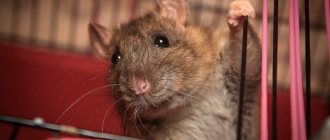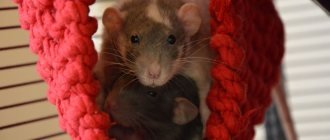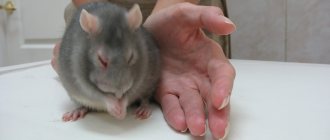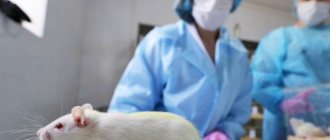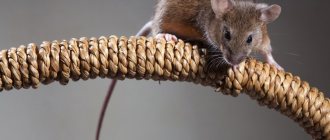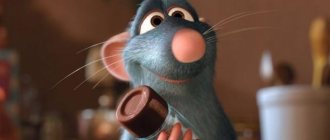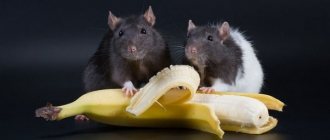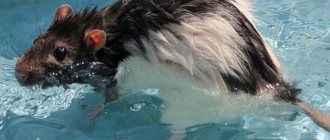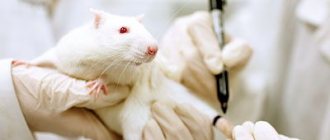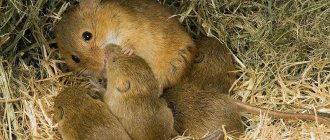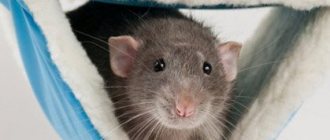Small, cheerful and intelligent rodents are an excellent choice for a pet. These include hamsters, guinea pigs and decorative rats. Some pet owners prefer to keep their animals one at a time. Others are interested in when animals have company or simply produce offspring, the characteristics of which can be influenced by choosing females and males. Breeding rats at home can be both an interesting hobby and a small income. But if you decide to start breeding rats and have acquired several animals, then it’s worth understanding all the intricacies of breeding these rodents.
Types of breeding
In domestic rats, two types of crossbreeding are possible: selection of different breeds and purebred breeding.
In turn, purebred crossing is divided into the following types:
- Linear crossing;
- Inbreeding;
- Outcrossing;
- Outbreeding.
Linebreeding
Linebreeding or line breeding of rats involves crossing individuals that have a common ancestor. This method allows you to obtain viable offspring with a good genotype. In this case, homozygosity is preserved, and characteristics that do not satisfy the breeder are leveled out.
Inbreeding
To consolidate important breed qualities, the inbreeding method is chosen. Breeding rats in this way involves studying the gene pool and selecting quality sires among close relatives. With close inbreeding, a decrease in the number of viable offspring is possible - so-called inbreeding depression. To reduce the risk of such a situation, individuals for breeding are selected according to strict criteria.
Outcrossing
Outcrossing is used when it is necessary to increase the number of litters with valuable qualities. Mating uses individuals obtained by linebreeding, but without common ancestors in the fourth or fifth generation. To improve the breed, young animals that are unsuitable for a good genetic line are removed from the litter.
Outbreeding
To improve the quality of the breed and the health of the litter, outbreeding is the best option. With such crossing, individuals of a pure breed are selected, but without common ancestors. The disadvantage of this method of breeding is that there is a risk of unplanned characteristics and with frequent use, after several generations the proportions of the animal change.
Despite the different selection options that can be combined, there is still an unpredictable result. This is manifested in the color and length of the coat, the number of individuals in one litter, eye color, and level of health.
Lifestyle and structure of the flock
In terms of feeding, the rat is very similar to humans. She eats everything, paying tribute to animal food. She is a good hunter, including birds and small mammals.
This animal has a nocturnal lifestyle. This is especially convenient when living with a person: the rat goes out to hunt while the person is sleeping.
It is primarily a social animal. A rat, of course, can live alone, but it prefers to be in a pack of 10-15 individuals or in a colony. The colonial way of life is possible, first of all, in nature.
Within each group there are complex hierarchical relationships. Each flock controls a territory of up to 2000 m². Rats leave their territory along paths that are marked with scent marks.
Hierarchical relationships develop predominantly among males, which is directly related to the reproduction of these animals.
Preparation for crossing
For healthy offspring, it is necessary to select a healthy pair of males and females with the necessary breeding characteristics.
Female
In this case, the age of the female, especially the primiparous one, is quite important. Individuals older than five but younger than ten months are suitable for reproduction. Females can become pregnant as early as 5-6 weeks. But it is not recommended to mate earlier than four months of age. If an individual bears offspring during this period, then crossing can be continued for up to a year.
Male
Diet and age affect the sexual activity of males. The appropriate age to start mating is six months. You can continue to mate a male until the end of his life. If a male has not mated at a young age, then his activity may decrease significantly.
Factors affecting reproduction
Despite the fact that rats breed a lot and often, there are a number of factors that have a serious impact on the reproductive functions of the rodent body.
Environment
The environment plays a huge role in the life of any living creature. A person is able to cope with this by building warm homes, creating clothes and other things to protect himself from the influence of the environment. Rats can't do that, so they've learned to adapt.
These rodents adapt perfectly to any climate, but the climate itself changes the rodents so that they do not die. So, if the population happens to live in frosty areas, the number of cubs that the female will give birth to will sharply decrease. The quality of the offspring will also suffer, as many pups will be stillborn.
Nutrition
Poor nutrition affects adult rats. Pet rodents always have access to healthy and tasty food, so they are full of energy and always healthy. Wild rats eat what they find under their feet, and this is not always food that is healthy for their body. Quite often, a rat can eat some kind of poison, but not die and suffer poisoning, but serious harm will already be done to its body . Read more about rat poisons in this article.
Living conditions
A hostile environment is often the main factor that disrupts the reproduction process. In a stressful state, when there are either traps set up or predators everywhere, female rats have a hard time with pregnancy, miscarriages often occur and dead rat pups are born. Just as mentioned above, due to the constant danger, rats may eat live young ones to protect them from predators. By carrying live rat pups from place to place, the female often exposes them to danger. Naked babies simply freeze while their mother carries them in her teeth.
Ecology
Chemical emissions into the atmosphere, radiation, and contaminated soil also have a detrimental effect on the health of rats. If poisoning can affect several individuals, then constant presence in the contaminated area affects the entire population. Childbirth is difficult, pregnancy is also difficult, mutations and the absence of the reproductive system in general are observed. The population begins to degenerate.
Sources:
https://zagorod-live.ru/borba-s-vreditelyami/myshi-i-krysy/kak-razmnozhayutsya-krysy.html https://homkin.ru/krysy/zdorovie-krys/razvedenie-i-sparivanie-krys .html https://xn—-gtbdaj1bvbjgo3a0g.xn--p1ai/unichtozhenie-gryzunov/krysy/kak-razmnozhayutsya/
Nutrition
Breeding rats presupposes a proper diet for rodents. After selecting individuals, it is necessary to adjust their diet in order to remove excess weight and make them more active.
To increase the endurance of a pregnant female, it is necessary to include wheat germ, eggs, fish and poultry in her diet. In this case, you need to exclude strawberries, vegetable oils, bell peppers and boiled liver from your diet.
Clean and fresh water in the drinking bowl is a vital element in the diet of ornamental rats, especially during the mating period. In addition, it is recommended to place the animals in a separate spacious cage for free movement.
Pairing
It is necessary to replant the male during the period of estrus. It occurs in females in the interval from four to ten days and lasts up to one day. During this period, the behavior of the individual changes. False matings can be observed when other females try to mount a female in heat. In such a female, the appearance of the vaginal opening changes - it acquires a purple tint, becomes open and wet. If you touch such an individual from above, it begins to arch its back and vibrate its ears.
Typically, rats need one male and one female to breed. But there are cases when mating occurs only when two or three females move in with the male. After birth, it is necessary to remove the male from the cage to avoid re-fertilization, because estrus is restored 36 hours after the birth of the brood.
Pregnancy can be tracked by the absence of estrus after a certain period of time. The abdomen enlarges after two to three weeks.
Wild conditions
The mating season for rats begins in the spring, both domestic and wild, i.e. Everyone has the same time to produce offspring. However, there are further differences.
In nature, the reproduction rate of rats is low. They mate only in spring and summer. This happens due to living conditions. If the region in which the population is located is cold and wet, mating rarely occurs. Usually this can be in the Far North, taiga, jungle, and so on. The opposite situation occurs if rodents live in a warm climate.
During mating, the male hunts for several females at once, after which each one becomes pregnant in turn . The pregnancy itself lasts only a month, sometimes less. Before giving birth, the female arranges a nest for the future offspring: she collects straw, leaves, branches, digs a hole and lays out the collected materials there. Then he brings food there, the reserves of which should be enough for the first weeks of the little rats’ lives. Usually about ten or fifteen babies are born at a time.
The cubs themselves are born completely naked, blind and incapacitated. Many functions of their body do not work, for example, digestive, which is why the mother licks their bellies so that all metabolic processes are normalized. But a little time passes, the pups grow fur, after seven days their eyes and ears open, after another week their teeth erupt, and towards the end of the month they can already move around calmly on their own. By this time, the pups turn into real adult rats and are able to live independently, separately from their parents, but they reach the size of an adult only after a year.
Pet rat pregnancy
The duration of pregnancy in decorative rats ranges from 20 to 24 days. The first two weeks of pregnancy will not be noticeable - the rat does not show its condition in any way and only begins to build a nest closer to the birth.
As soon as you suspect that an individual is pregnant, you need to expand her diet to include apples, poultry and fish, cottage cheese, and nettles. Products containing protein, calcium and vitamins must be present. You should exclude grapes, lettuce, garlic, onions, tomatoes and egg yolks from your diet.
To replenish fluid there must be clean, preferably spring water. Closer to birth, you need to prepare the nest. Zoological stores sell ready-made options in the form of plastic or wooden houses larger than usual for rodents. You also need to provide the female with building material in the form of unpainted paper and pieces of natural fabric.
Breeding rats at home requires the breeder to be extremely careful and careful. Stress factors should be avoided throughout pregnancy. Such, for example, as introducing new animals into a cage and moving the female to another place.
Distribution and settlement
Rats are intelligent and well-organized creatures. Throughout the history of man, or rather since the time when people became farmers, animals have been man's worst enemies. They gnaw through the walls of wooden houses, freezing them out, eat supplies, including grain and potatoes, and finally, like real predators, they are capable of stealing chickens, ducklings, rabbits and other pets.
The rat is the enemy of man with an aura of mysticism. It is not for nothing that in Siberian villages it is customary to throw a murdered gray robber out into the very middle of the street, and the offspring of cats capable of hunting rats are very quickly disassembled for military service in farmsteads. After all, not every feline can cope with a seasoned mammal. Ratcatcher is not only a profession, but also an honorary title.
A gray rat, or pasyuk, lives in human houses. It belongs to the synanthropic cosmopolitan species from the order of rodents. Synanthropic is someone who lives next to a person. A cosmopolitan is a species found everywhere except perhaps Antarctica. However, along with the cargo of the polar explorers, the rat could have penetrated there too.
Of all the rats in Russia, the pasyuk is the largest. The length of its body without a tail ranges from 17 to 25 cm. If you measure an animal with a tail, the size can increase by another 20 centimeters. This adult animal weighs on average about 250 g.
The Pasyuk’s homeland is East Asia, or more precisely, the territory of modern China. Thanks to their plasticity, after the glacier left, rats began to settle along river valleys. However, this process was extremely slow. The rapid expansion of the animal began from the moment of navigation and active international trade.
In nature, gray rats prefer to stay in valleys near water bodies. Where natural conditions are especially harsh, they live only in human dwellings. In temperate zones, these animals can move into nature for the summer and return to humans for the winter. Where winters are mild and there are no negative temperatures at all (or they do not last long), rats prefer to live in the wild, only occasionally visiting human homes.
Thus, the rat becomes man’s worst enemy in the taiga and tundra zones, where it can only live with humans.
Birth of the brood
Throughout the entire period of childbirth, the female should be in silence, darkness and peace. Otherwise, labor may be disrupted. If the pregnancy proceeded normally, the individual is healthy, then an uncomplicated birth lasts for an hour to an hour and a half. There can be from eight to fifteen rat pups in a litter.
After giving birth, you should not disturb the nursing individual, at least until the tenth day, when the young will leave the nest on their own.
It is worth avoiding cases when there are two females with cubs in a cage. They can be aggressive to the point of eating the brood of another individual.
After giving birth, the female must have a varied diet and water. Often, lack of water can cause a mother to eat her litter. After 5 weeks, the cubs must be separated from their mother to prevent the mother from fertilizing her sons. 6 weeks after birth, you need to separate yourself and the males in the litter separately.
Signs of approaching labor
For a comfortable birth and calm care of the babies, the rat needs to prepare a separate cage where no one will disturb it. It is better to transplant a pregnant female a couple of weeks before giving birth, so that she has time to prepare the nest and get used to the new territory.
You can understand that the deadline is approaching by the behavior of the animal. He becomes aggressive, takes food from his relatives, and frees up the space he likes for himself. The rat begins to arrange the place where the babies will be born. A few hours before giving birth, mucus drains from the vulva.
Young ornamental rats
Rat cubs are born with closed ears, blind, shortened tails, underdeveloped limbs and no hair. Their weight is four to six grams. For the first weeks, the pups depend on their mother. For full growth and development, it is vital for them to satisfy the sucking reflex.
3-4 days after birth, the ears open. On the sixth day, the first fur is formed. Teeth erupt after 8-10 days.
Only after two weeks the eyes open. At the same time, the sex of the baby rats can be determined. Females have small nipples.
After eighteen days, the coat becomes thicker. The animals show more independence and may attempt to eat solid food.
After three weeks, the pups are independent enough to clean their own fur and eat adult food.
The young develop throughout the year. Their growth is significantly influenced by their diet - it must be rich in proteins to fully build bones and muscle mass.
Bathing
Despite the widespread belief that pet rats love water, they are far from fond of bathing. Water procedures can be complicated by the animal’s pronounced resistance, but some pets are tolerant of this procedure - it all depends on individual characteristics. You need to bathe an animal in the following cases:
- if the wool has an unpleasant odor;
- if the rodent is unwilling or unable to care for itself;
- when infected with parasites.
Artificial feeding
In some cases, when the female dies after giving birth or refuses to breastfeed, you can try to feed the cubs to the child's family. Insulin syringes are used for this. Infant formula is taken in the proportion of 1 part to 50 ml of condensed milk with a high fat content of up to 12%, including half a tablet of calcium gluconate. It is acceptable to use milk replacers for cats or dogs.
Feeding should be done frequently with gradually increasing portions. It is preferable to give such cubs to another lactating female if she accepts them.
In conclusion, it should be said that breeding rats is quite a fascinating process, but do not forget that by crossing different species you can create something completely unusual.
Did you like the article? Share with friends: [supsystic-social-sharing id=”1"]
- Related Posts
- How rats laugh and why they do it
- How to give a rat an injection in the withers, subcutaneous, intramuscular
- Rats in heat
« Previous entry
